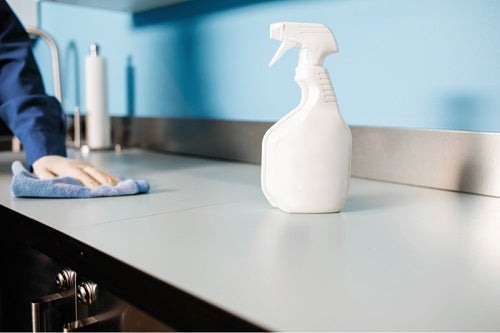With the ongoing pandemic and the flu season around the corner, it’s important to develop a plan for using disinfectants efficiently and effectively. There’s a time and place for cleaning, and a time and place for disinfection, and doing the right amount of each can help safeguard public health. During the pandemic, disinfectant use is on the rise, and there is a growing conversation around overuse of disinfectants.

To address this concern and make the most of the limited products available during the pandemic, it’s important to target disinfection to the surfaces and places where it is needed most. Depending on the type of facility and how people are using that facility, some areas might require cleaning only, while others may need both cleaning and disinfection. Smart disinfection—that is, targeting disinfectants to when and where they are needed most—can help conserve disinfectants and maximize protection for the people who use those spaces.
Cleaning, Sanitizing and Disinfecting
Before deciding on a plan for smart disinfection, it’s important to know the difference between cleaning, sanitizing, and disinfecting. Cleaning is the physical removal of dirt and debris from surfaces. Cleaning products contain a surfactant or detergent to break up dirt and debris, but are not Environmental Protection Agency (EPA) registered. Cleaning products cannot make claims to kill bacteria or viruses on surfaces. Sanitizers and disinfectants contain an antimicrobial active ingredient and are EPA registered. Sanitizers reduce the number of bacteria on surfaces, but cannot make claims against viruses, so they cannot be used to kill for example SARS-CoV-2, the virus that causes COVID-19. Disinfectants can be registered to kill bacteria, fungi and viruses on surfaces, including SARS-CoV-2. Some products are one-step cleaner disinfectants, meaning that they contain both surfactants and an antimicrobial ingredient, so they can clean and disinfect in the same step.
When and Where to Disinfect
Manual disinfectants like wipes and trigger sprays are great tools for regular disinfection of spaces and surfaces that people touch frequently throughout the day. In schools for example, it makes sense to disinfect desks, doorknobs and other high-touch surfaces by wiping or spraying them in between classes, but you may not need to disinfect every surface in every room throughout the day. On the other hand, high traffic areas like restrooms may need to be disinfected top to bottom, multiple times throughout the day. According to the Centers for Disease Control and Prevention (CDC), high-touch surfaces that may require frequent disinfection throughout the day include tables, doorknobs, light switches, countertops, handles, desks, phones, keyboards, toilets, faucets, and sinks.1,2
Thorough cleaning and disinfection of the entire facility usually happens after hours, after building occupants have gone home. This process could involve cleaning (such as vacuuming and dusting), followed by manual disinfection with wipes, trigger sprays or dilutable disinfectants.
For extra assurance that all surfaces are disinfected, electrostatic spray disinfection can be added to and even replace parts of this routine. For example, you could clean high-touch surfaces in classrooms, and then use an electrostatic sprayer to apply a disinfectant quickly and evenly to all surfaces in the room. This could include soft surfaces or surfaces that are difficult to thoroughly clean, such as chairs and desks. Electrostatic spraying can also be used as a substitute for manual wipes and sprays in areas that are large and hard to disinfect manually, such as restrooms, locker rooms or cafeterias. Keep in mind however that high-touch surfaces should still be the focus when using an electrostatic sprayer in public spaces. For example, although walls and floors can be disinfected, these areas may only require cleaning depending on the facility type and room traffic.
Develop a Smart Disinfection Plan
To develop a smart disinfection plan, first determine which surfaces and areas in your facility need to be disinfected. Once you’ve identified the areas and surfaces in your facility that need to be disinfected, you can develop a plan to decide when those surfaces should be disinfected and by whom. Let staff know who is responsible for each area, and what needs to be done in that area. Checklists are a great tool to help staff and managers keep track of what has been done throughout the day. Staff should also be trained on the safe use of disinfectants. Disinfectants are safe when used as directed, so it’s important to always follow label instructions for use. Appropriate personal protective equipment should also be worn by the operators applying disinfectants.
If you need guidance to help you complete your smart disinfection plan, there are several comprehensive tools and resources available. For example, the CDC has guidance on cleaning and disinfecting public spaces, offices and businesses, schools, and homes that includes a disinfection decision tree.3 For educational facilities, there are multiple resources available on cleaning and disinfection, including information on how to open facilities safely.4,5
For the latest information on COVID-19 and variants, visit our CloroxPro COVID-19 Hub.
References
1. Centers for Disease Control and Prevention (CDC). Cleaning and Disinfecting Your Facility https://www.cdc.gov/coronavirus/2019-ncov/community/disinfecting-building-facility.html (accessed Sep 3, 2020).
2. Centers for Disease Control and Prevention (CDC). Cleaning And Disinfecting Your Facility https://www.cdc.gov/coronavirus/2019-ncov/community/disinfecting-building-facility-H.pdf (accessed Aug 28, 2020).
3. Centers for Disease Control and Prevention (CDC). Guidance for Cleaning and Disinfecting https://www.cdc.gov/coronavirus/2019-ncov/community/cleaning-disinfecting-decision-tool.html (accessed Aug 28, 2020).
4. National Education Association; The Clorox Company. Cleaning , Sanitizing , and Targeted Disinfecting in the Classroom.
5. Centers for Disease Control and Prevention. Guidance for Cleaning and Disinfecting https://www.cdc.gov/coronavirus/2019-ncov/community/pdf/Reopening_America_Guidance.pdf.


